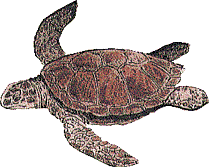
Scientists often take multiple measurements and average them to come up
with the most accurate measurements possible. Each of the research teams in
your class has now been to your aquatic site and taken. Now you need to pool
your information. Sharing your data will help you get a more realistic
impression of your aquatic site.
As you filled out Master 4a, your site scored a certain number of points for
many of your measurements. For example, it received a certain number of
biotic index points for the types of invertebrates you collected. It also scored
a certain number of abiotic index points for the pH readings, dissolved oxygen
levels, and temperature readings. Now let's see how your measurements
compare to the measurements taken by the other research teams in your class.
Materials
For each research team:
Methods
- Make that sure your team has completely filled out Master 4a, including the
calculation of the total number of biotic and abiotic points. What did all of
your field work tell you about the site's ability to support life?
- Review the data that the other teams obtained at the aquatic site. How are
these data similar to, and different from, those of your team?
- Using the data from all the teams, compute the averages for the data.
Record the averages on your team's blank copy of Master 4a. How did your
team's results differ from the average measurements?
Conclusions
Discuss the following questions as a class and record your answers in your
JASON Journal.
- Study the average invertebrate count on Master 4a. Would you say that the
number of animals counted at the aquatic site suggests a wide diversity of
life? Why or why not?
- What does the invertebrate count tell you about the level of stress on the
environment?
- What do your abiotic readings tell you about your site's ability to support
life? Do all of the readings tell you the same thing? If not, why?
- How do you think the biotic and abiotic characteristics relate to one
another?
- What new questions do you have?
- How would you check to see if your answers to the focus questions are correct?
Would you consult resources at a local library, university, or online? Would you
consult with peers on the Internet using the Student Discussion Group, part of
the JASON Online Systems? How else might you check your answers?

Return to the Aquatic Field Investigation
JASON VII Home Page


JASON Project Homepage ||
Teachers' Guide ||
Students' Corner ||
Search
Gene Carl Feldman
(gene@seawifs.gsfc.nasa.gov)
(301) 286-9428
Todd Carlo Viola, JASON Foundation for Education (todd@jason.org)
Revised: 3 Nov 1995
![]()
![]()